Fighter Pilot Down – A Eulogy Dtd: 7-28-00
From: LtCol Gregory J. Johnson, USMC (Ret)
Subject: NOTAM (Notice to Airmen): Fighter Pilot Down
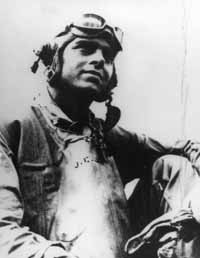
1. Colonel James E. Johnson, USMC (Ret) departed pattern 0500 Zulu, 27 July 2000. Last seen on heading and course, full throttle forward, afterburners glowing. Last report indicates passing through Angels 300. He was 81. PCS (Permanent Change of Station) orders and flight plan come on wake of two year battle with leukemia. Received orders at home in Kaneohe, Hawaii. At last PIREP (Pilot Report), Subject Named Marine (SNM) indicated “six” was clear.
2. Born into family of limited circumstance in St. Louis, Missouri during 1919, SNM, like millions of his generation, would go on to serve country with honor and distinction, not only in World War II, but also Korea and Vietnam. Along the way, made good friends, commanded many Marines, and raised a family the best he could. Like most of his era, who are departing at the rate of 1000-plus per day, gave more than he took. Not to say he was without reward. SNM would be the first to tell you it was his honor and privilege to live in, and serve the United States of America. SNM would tell you he was one lucky guy!
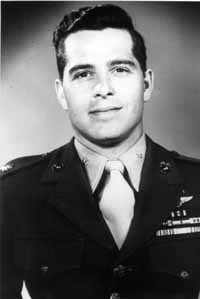
3. Although never achieving notoriety or fame to the degree of fellow fighter pilots like Pappy Boyington, Joe Foss, John Glenn, John L. Smith, Paul Fontana, Tom Miller, or even “The Great Santini,”–nevertheless held his own. All-in-all SNM did Sierra Hotel job. Call sign “Hollywood” (dubbed by fellow pilots in deference to his good looks and impact on lovely ladies), he would likely tell you he was just an average guy trying to do an above average job.
4. Summary of service characterized in OPREP (Operations Report) previously conveyed in transmission to public three years ago by SNM’s senior Marine Junior. Reference cites action during battle for Guadalcanal. Partial recount of subject report follows. First reported under title: “First Fright”…
Jimmy Johnson was a champion athlete. He attended college on an athletic scholarship where he participated in football and track. He would compete athletically on a daily basis and achieve a considerable degree of success. With many daily challenges met and won on the playing fields, he still, nevertheless, wondered if there was more he could measure up to. World War II would quickly bring him that answer.
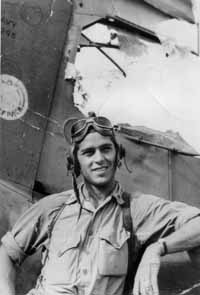
Johnson arrived at Guadalcanal on November 2nd, 1942 as a member of Marine Fighter Squadron 112–the Wolf Pack. Along with two dozen pilots and 234 enlisted Marines, Johnson had sailed from San Diego three weeks earlier. At the age of just 22, Johnson would soon be introduced to aerial combat. And he has never forgotten his first mission…
Flying from Henderson Field, Johnson and his squadron mates, under the command of Major Paul Fontana, were ordered to strafe Japanese destroyers coming down the “Slot” in the Solomon Islands chain. Inbound to their target, flying F4F Wildcats, periodic tastes of bile served notice to Johnson that the proverbial knot in his stomach was increasing in size. This was not unlike the tension he had experienced before the start of an athletic event. However, the lacing of real and total fear was an entirely new ingredient in the equation. Notes Johnson: “Fortunately, I was a section leader in the forward flight led by Major Fontana. My position in that flight left the remainder of my squadron mates behind me. As much as I suddenly and shamefully wanted to turn and drop back, I couldn’t. My sense of pride was just too big to let fear take total control of me. Also, I couldn’t let my squadron mates down. So I stayed with the Skipper and went into my first battle.” Expounding on the virtues of his CO, Johnson relates ” Major Fontana was a remarkable leader. Interestingly enough, he did not really have that much more flight experience than the rest of us nuggets he was leading. This is one more testament to his greatness. The Skipper led us in on three destroyers like he had been doing this all of his life. On our low angle dives into the destroyers, large red tracers the size of baseballs flashed by us as we closed in for the attack. Our aircraft took hits in the fracas, but fortunately we did not lose anyone. Going into the last of these three very frightening attacks, Major Fontana gave us the signal to rendezvous following the run. We would head back home after that. Unfortunately, as I was completing this run, the Curtis electric propeller on my aircraft went into full flat pitch. This is like having your car shift into neutral on a busy freeway at rush hour. I could not restore any pitch to the propeller despite very vigorous activity on the prop control lever. With enough energy available to complete the attack, I glided past the destroyers losing altitude quickly as energy ran out. Plumes of white water, the result of flat trajectory fire, bracketed me as guns from the destroyers swung across the deck firing at me the whole time. I was preparing myself for a water landing and had just lowered my flaps, prior to ditching, when the propeller automatically went from full flat pitch to full high pitch. This is analogous to driving a car stuck in first gear.”
Like an invalid negotiating dangerous territory, Johnson nursed his ailing Wildcat away from the destroyers while cautiously climbing into a darkening sky. At a safe altitude, he leveled off. Johnson adjusted the throttle and mixture, but left the malfunctioning prop control lever alone for fear of becoming a glider pilot again. With power restored and all alone, Johnson turned his aircraft in the direction he thought would take him back to Henderson Field. By now it had clouded up and was beginning to get dark as sunset approached. The strip maps carried by the pilots for navigation were not much help under these circumstances. With the engine turning high RPM and consuming fuel rapidly, Johnson figured he would fly until the tank ran dry. At that point, he would bail out and hope for the best. It was raining lightly as Johnson motored on. His mind drifted as he watched rain droplets produce hundreds of beads on his plexiglas canopy. He thought about his parents back home and how they would take the report of his soon-to-be missing in action status. His fuel gauge was hanging on empty. Things were not looking good. “All of sudden,” Johnson notes, “I spotted what appeared to be a searchlight poking up through the clouds. The folks at Henderson Field knew some of us were still possibly out and lost. At great personal risk, they provided us a means to find our way back. I immediately throttled back on power and went into a dead man’s spiral. Fighter One (Henderson Field) popped into view as I descended through the undercast. I landed on a muddy runway and was rolling out when the engine conked out. I had run out of fuel!”
And so it was that Second Lieutenant James Johnson completed his first combat mission. Johnson was lucky. Jake Stub, Joe Foss, and a few others who were on the multi-squadron mission did not make it back. “Foss and Stub” Johnson relates, “did eventually show up a few days later-thanks to friendly natives and those wonderfully brave coast watchers.” As for the mission, it was successful. One destroyer was knocked out. The remainder of the force got beat up and turned around.
After that first mission, many others would follow. Many would be even more harrowing than his first. However, says Johnson, “My first combat mission remains my most distinct. It is just as vivid today as it was over 55 years ago!”
What does Johnson offer in the way of advice to those pilots who will go into battle in the future for the first time? “After that first mission was under my belt, I felt pretty good about myself. I had a confidence that took the edge off that ever-lingering element of self-doubt and betrayal that accompanies the fear you have when you know you truly have the potential to get yourself killed. I want future combat pilots to know that when the reality of the first commitment to do battle arrives, the utter fear that betrays all the positive things you have thought about yourself will be present. That is a given. It is the human condition. To that I offer this advice: Believe in your training; believe in your equipment; and believe in your leaders. But most of all, believe in yourself. It will carry you through and make you a champion. Of course, throwing in a prayer or two doesn’t hurt either.”
A special fraternity exists between those who have met and survived the challenges of combat. It is a universal bond that must be experienced to be fully appreciated. No matter what degree of training or level of experience naval aviators achieve, there is no sure-fire way to actually prepare for the first true taste of combat. One can never really know how he or she will measure up in terms of courage until he/she actually confronts the truth of fear. As the void which depletes the number of combat-experienced pilots on hand from Vietnam and the Gulf War continues to open, it is important that we address this situation in terms of conveying to our warriors the personal challenges which will confront them when they step up to aerial combat. The demands of war can never really be understood or prepared for during peacetime. It can be approximated, but it can never truly be simulated. Individual behavior is unpredictable and that is why it is important to understand ourselves and the mechanism that makes each one of us tick. We must learn as much as we can from those who have gone before. Generations must continue to pass the intangibles of their knowledge on to others in order to help us maintain the edge we always seem to enjoy.
5. As a young kid growing up on multiple Marine Corps Air Stations, it was this reporting officer’s privilege to know many other wonderful men and women of the Marine Corps like Jim Johnson. Recent years ago, I was invited to attend 50th anniversary reunion of Wolf Pack’s arrival on Guadalcanal. The reunion was held in New Orleans. Members of squadron gathered to renew friendships and reflect on days long ago that forever changed their lives. The New Orleans reunion was as much an education in leadership as demonstration of camaraderie. No agenda was set but spontaneous individual tributes paid to their former squadron commander left few dry eyes in the place. The assembled men I observed that evening were mostly in their early to mid-70s. Gray eagles so to speak! But in their minds that night, I could discern these Marines were actually still young brothers in arms–youthful pilots tested in combat against worthy adversaries. The bravado, fire, and determination that began fifty years earlier still burned brightly that night in their eyes. And the humor that once allowed these brave warriors to cope with adversity had not diminished either. Humor and brotherhood were dispensed liberally… The best sequels are ones that know why the original was a success. The Wolf Pack’s personality observed that evening in New Orleans was special but obviously not new. It was born 50 years earlier when a special man named Paul Fontana assembled a group of young men together and took them off to war in Pacific. Drawn to each other by service to country and their Corps, the Wolf Pack epitomized loyalty, honor, integrity and most of all, consummate professionalism. Jim Johnson relished his association with these warriors.
Now this is the Law of the Jungle –
as told and as true as the sky;
And the Wolf that shall keep it may prosper,
but the Wolf that shall break it must die.
As the creeper that girdles the tree-trunk
the Law runneth forward and back –
For the strength of the Pack is the Wolf,
and the strength of the Wolf is the Pack.
– Rudyard Kipling, Second Jungle Book
Colonel James E. Johnson, USMC (Ret), attended the University of Missouri on an athletic scholarship where he participated in football and track. He was the 1940 Big Six Conference High Hurdle Champion. He was selected to compete on the U.S. Olympic Team that was later cancelled due to the war in Europe. He enlisted in the Navy’s V-5 program his junior year in college and was designated a naval aviator in May of 1942.
Accepting a commission into the Marine Corps, Johnson saw combat action during World War II at Guadalcanal where he was credited with four aerial victories flying the F4F Wildcat and F4U Corsair, all with his beloved Wolf Pack of VMF-112. After the war, Johnson was active in interservice football as both a player and coach. He declined an invitation to leave the Marine Corps and play defensive back for the Los Angeles Rams, preferring instead, to lead Marines and fly jets.
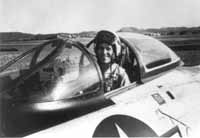
During his military career, Jim Johnson commanded VMF-115 (Korean War), MARS-17, VMF-311, and 1st ANGLICO. Following a tour as aide de camp to the Commandant of the Marine Corps, Jim Johnson went on to command Marine Aircraft Group 24, and the 24th Marine Expeditionary Unit. From early 1964 through 1965, Johnson served in Vietnam.
Jim retired in 1968 following 27 years of service and 4100 hours of flight time, mostly in fighter and attack aircraft, but also helicopters with Marine Aircraft Group 16. Personal awards included two awards of the Distinguished Flying Cross, Air Medal with one silver and six gold stars, Navy Commendation Medal, as well as numerous other personal, unit, and campaign commendations.
7. As this reporting officer comtemplates SNM’s passing, I keep being drawn to the image of his generation–the “Greatest Generation” as Tom Brokaw describes it. Many call SNM’s generation the “Depression Generation.” Being there was nothing “depressing” about them, I prefer to think sobriquet “Greatest Generation” most appropriate. Addressees to this message (especially boomers and beyond) should marvel at what this Marine and ALL those like him did for this nation. Subject reporting officer has oftened wondered what tribute subsequent generations can best pay to this group. The answer was not previously clear until after reading Brokaw’s book “The Greatest Generation.” The answer?: The best tribute we can give these warriors is to reclaim a national spirit and purpose for present and future generations of Americans. Don’t treat the “Greatest Generation” as relics of the past. The country’s best days can still be those ahead. This will be best tribute and legacy we can give to those who came before us. We have a challenge! And we can fulfill it!
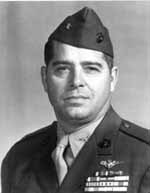
8. The chocks have been pulled. Jim Johnson has departed on the ultimate solo. His personal rendevous with destiny has begun. There can be little doubt he will join numerous comrades-in-arms who are currently patrolling the skies and unlimited airspace of heaven. SNM will be missed, but not forgotten.
Semper Fi Colonel. Farewell Dad.
Johnson out…
-End of Transmission-
